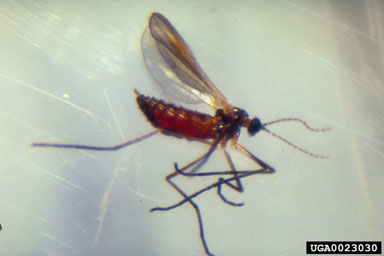Zeuxidiplosis giardi
Klamath weed midge
(Diptera: Cecidomyiidae)
Insect
Links Pictures
 Origin:
Origin: This
biological control agent
originated in France. (1)
The Life Cycle:
Overwintering stages: As larva and pupa. (1)
Egg Stage: Eggs are laid on the leaves or stems. A
female
will produce around 170 eggs, which are elongate, .33 mm (.012") long,
and
pale red. Eggs hatch in about 12 days. (2)
Larval Stage: Newly emerged larvae enter the leaf bud and form
galls.
Their feeding causes the leaves to grow together creating a hollow
chamber
or bivalved gall in which the 2 mm (.08 in), red-orange larvae
develop.
Several larvae are often found within the gall.
Pupal Stage: Pupation occurs inside the gall.
Depending
on the temperature and time of year, pupation may last from 6-20
days.
Pupae are yellow-red, but they may become darker as they mature. (2)
Adult Stage: The adults only survive for a few days.
The
adults are very small and delicate. They are gray flies that
slightly
resemble fungus gnats. (3)
Effect:
Type of Damage to Host: The agent becomes destructive during
the larval and pupal stage. It produces leaf bud galls and leaf
galls.
The feeding inside of the gall sometimes causes the weed to die.
The feeding causes the leaves to grow together. The insect causes
harm to a weed called St. Johnswort (
Hypericum perforatum).
Galls are formed on the leaves of the weed to create both protection
and
nutrition for the insect. (4,5)
Impact on the Host: The plant
loses vigor, foliage, and
root
development. Infected plants may die in the dry seasons due to
their
incapability to store and obtain moisture. This agent reduces
growth
and seedling survival. It has been successful only in Hawaii for
controlling the weed, St. Johnswort. (5)
Releases:
Releasing of the Insect: The midge prefers damp
locations with
moderate to high relative humidity. It does not do well in dry
summers
and windy areas. It does not live in areas of much
livestock.
You should transfer the midge in the larval stage when it is galled in
the plants. It was first introduced to the U.S. in 1951 in
California.
It is now established in California, Oregon, and Hawaii. Releasing
should
not take more than three days. You should keep the roots wrapped in a
moist
paper towel. No storage is needed. (3)
Comments: There
is apparently a larval resting stage
during the
summer and it is not known whether this is because of a type of
dormancy
or is heat related. It has been suggested that as the larvae feed, they
inject a chemical substance into the sap of a plant (which causes the
plant
to form galls). A large number of larvae feeding along the stem
may
cause death of the stem and root system. In Hawaii, there has
been
a drastic decrease of the population of St. Johnswort in areas where
the
insect is established. (3) Therefore, way to go gall midge!
Keep up the good work! It may be too cold and windy in most
areas of Montana for this insect to do well but, that is not yet known.
[Mr. Breitenfeldt]
Bibliography
(1) Wister, B. (1999, September). Klamath Weed Midge [on-line].
Available: <
http://www.mcn.net/`rosebudweed/Klamath2.htm>.
(2) Rees, Naman, et. al., Ed,
Biological Control of Weeds in
the
West, Western Society of Weed Science, in the cooperation with the
USDA ARS, Montana Dept. of Ag., and MT State University, Color World
Printers,
Bozeman, MT, Feb. 1996.
(3) Withers, T. (1999 August). Zeuxidiplosis
Giardi
[on-line].
Available: <http://www.bishop.hawaii.org/bishop/ento/Aocat/cecido.html>.
(4)
Adam, Liberman.
(11 Novenber, 2004). Zeuxidiplosis Giardi [on-line].
Available: <http://www.ento.csiro.au/aicn/system/c_1149.htm>.
(5) Los, W. (1999-2008). Zeuxidiplosis
Giardi [on-line].
Available: <http://www.biolib.cz/en/taxon/id117067/>.
By: Justin
Wehner. 3-2008.
